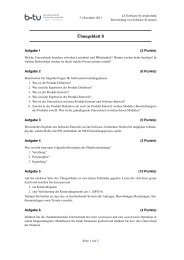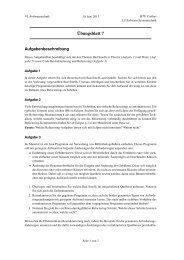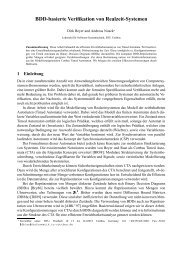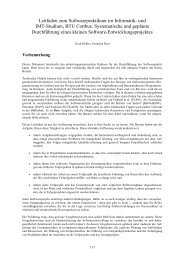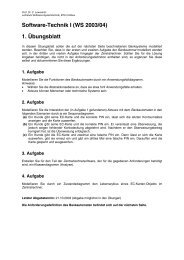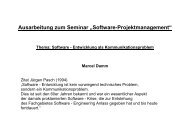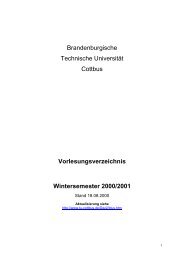Rabbit: Verification of Real-Time Systems
Rabbit: Verification of Real-Time Systems
Rabbit: Verification of Real-Time Systems
Create successful ePaper yourself
Turn your PDF publications into a flip-book with our unique Google optimized e-Paper software.
<strong>Rabbit</strong>: <strong>Verification</strong> <strong>of</strong> <strong>Real</strong>-<strong>Time</strong> <strong>Systems</strong><br />
Dirk Beyer<br />
S<strong>of</strong>tware <strong>Systems</strong> Engineering Research Group<br />
Technical University Cottbus, Germany<br />
db@informatik.tu-cottbus.de<br />
Abstract. This paper gives a short overview <strong>of</strong> a model checking tool for Cottbus <strong>Time</strong>d Automata, which<br />
is a modular modeling language based on timed and hybrid automata. For timed automata, the current<br />
version <strong>of</strong> the tool provides BDD-based verification using an integer semantics. Reachability analysis as<br />
well as refinement checking is possible. To find good variable orderings it uses the component structure <strong>of</strong><br />
the model and an upper bound for the BDD size. For hybrid automata, reachability analysis based on the<br />
double description method is implemented.<br />
1 Introduction<br />
Keywords. Formal verification, <strong>Real</strong>-time systems, <strong>Time</strong>d automata, BDDs<br />
Nowadays, s<strong>of</strong>tware engineering research <strong>of</strong> real-time systems has to investigate methods for formal<br />
specification and verification. Our research group works on formal methods and tries to define development<br />
processes for systems like production cells or real-time algorithms. As basic formalisms<br />
we chose hybrid automata [Hen96] and timed automata [AD94] because they have a well-founded<br />
theoretical basis. Reachability analysis <strong>of</strong> such models has been implemented in several tools, e.g.<br />
HyTech, Kronos and Uppaal. From our point <strong>of</strong> view, two major problems are the lack <strong>of</strong> concepts<br />
for modeling large systems and the exploding consumption <strong>of</strong> time and memory by the verification<br />
algorithms. We address these issues with our tool <strong>Rabbit</strong> providing the following features:<br />
– Modular modeling using an extension <strong>of</strong> timed and hybrid automata called Cottbus <strong>Time</strong>d Automata<br />
(CTA) [BR98]. Automata describing the behavior <strong>of</strong> the system are encapsulated by modules.<br />
Communication with other modules is possible via shared variables and synchronization<br />
labels declared within an interface. Each interface component has a particular access mode (read<br />
only, exclusive write, etc.) to restrict the use <strong>of</strong> variables and synchronization labels. Replicated<br />
subsystem components do not have to be multiply defined. They are instantiated from a common<br />
template module. Subsystem descriptions can be grouped to build hierarchical structures. An extension<br />
<strong>of</strong> the formalism leads to a compositional semantics, i.e. we can define the semantics <strong>of</strong><br />
a CTA module on the basis <strong>of</strong> the semantics <strong>of</strong> its components [BR01].<br />
– Reachability analysis. The tool provides efficient reachability analysis for timed automata using<br />
a BDD representation based on an integer semantics. We use the modular structure to compute<br />
variable orderings allowing for efficient representation <strong>of</strong> the transition relation (resp. the set <strong>of</strong><br />
reachable configurations). The reachability analysis for hybrid automata is based on the double<br />
description method (DDM) [FP96].<br />
– Refinement checking. To make verification <strong>of</strong> large systems tractable, the notation allows to<br />
replace specific modules by more abstract versions. To prove the correctness <strong>of</strong> this replacement,<br />
we have to check whether two modules have the same behavior respecting external synchronization<br />
labels. The tool checks the refinement relation by checking the existence <strong>of</strong> a simulation<br />
relation.<br />
– Framework architecture. The tool is built following the idea to have a platform for model<br />
checking <strong>of</strong> timed as well as hybrid systems. It is capable to use other representations, also from<br />
foreign libraries. Currently, the tool chooses dynamically the BDD representation if the model<br />
consists <strong>of</strong> (closed) timed automata. Otherwise, having a model consisting <strong>of</strong> hybrid automata,<br />
the tool uses the DDM library.
c = l i , c’ i := 0<br />
One Two<br />
c i >= l i , c’ i := 0<br />
c
1 MODULE TwoState {<br />
2 INPUT<br />
3 l: CONST;<br />
4 u: CONST;<br />
5 INITIAL STATE(twoState) = one AND c = 0;<br />
6<br />
7 AUTOMATON twoState {<br />
8 STATE one { INV c + 1 = l;<br />
10 DO c’ = 0;<br />
11 GOTO two;<br />
12 }<br />
13 }<br />
14 STATE two { INV c + 1 = l;<br />
16 DO c’ = 0;<br />
17 GOTO one;<br />
18 }<br />
19 }<br />
20 }<br />
21 LOCAL<br />
22 c: CLOCK(13); // (u + 1)<br />
23 }<br />
24<br />
25 MODULE System {<br />
26 LOCAL<br />
27 l = 9 : CONST;<br />
28 u = 12 : CONST;<br />
29 INST automaton1 FROM TwoState WITH {<br />
30 l AS l;<br />
31 u AS u;<br />
32 }<br />
33 INST automaton2 FROM TwoState WITH {<br />
34 l AS l;<br />
35 u AS u;<br />
36 }<br />
37 }<br />
Fig. 2. The textual representation <strong>of</strong> the ’two state’ model.<br />
applying such partial transition relations sequentially is more efficient than using the union <strong>of</strong><br />
these relations as monolithic transition relation [RAB 95].<br />
When using several partial transition relations, we have to determine the order <strong>of</strong> their application.<br />
The intermediate sets <strong>of</strong> reached configurations in the reachability algorithm depend on this<br />
ordering, and therefore the size <strong>of</strong> the intermediate BDDs. A bad ordering <strong>of</strong> the partial transition<br />
relations can result in intermediate BDDs that are much bigger than the final BDD <strong>of</strong> all reachable<br />
configurations. Always computing the fixed point using only discrete transitions before applying time<br />
transitions is a successful strategy to avoid this problem.<br />
Variable Ordering. Using the BDD representation we have to find good variable orderings. We<br />
start with an initial ordering and then we apply a heuristic to increase the quality <strong>of</strong> the ordering. We<br />
take the pre-order linearization (parent node first, then its children together, recursively applied) <strong>of</strong><br />
the CTA model as initial variable ordering. This implies that we consider the modeler’s decision to<br />
encapsulate some components together within one module, i.e. local components <strong>of</strong> a module are assigned<br />
to neighboring positions within the variable ordering. Then we apply another heuristic, which<br />
optimizes the ordering respecting an estimate for the size <strong>of</strong> the BDD representing the reachable set<br />
<strong>of</strong> configurations. This estimate is based on an upper bound for the size <strong>of</strong> the BDD for the transition<br />
relation [Bey01b]. It reflects the two most important characteristics for good variable orderings:<br />
(1) Communicating components have neighboring positions within the ordering. (2) Components<br />
which communicate with many other components precede these other components within the ordering.<br />
In difference to the most existing BDD applications we prefer to use that static ordering instead<br />
<strong>of</strong> dynamic reordering, which consumes a lot <strong>of</strong> run-time. Compared with the BDD-based version <strong>of</strong><br />
Kronos [BMPY97] and Wang’s tool [Wan00], our strategy for variable ordering leads to a significant<br />
performance improvement.<br />
We illustrate the dramatic influence <strong>of</strong> the variable ordering on the size <strong>of</strong> the BDDs representing<br />
the reachable set. Figure 3 gives the shape <strong>of</strong> the BDD for the set <strong>of</strong> all reachable configurations for
8 Fischer processes. The large one (light grey) uses the ordering ’k at last’ (which invalidates one <strong>of</strong><br />
the characteristics for good orderings) and the small one (dark grey) uses ’k in front’. We visualize a<br />
BDD in the following way: each pixel represents one BDD node and each horizontal line represents<br />
all the nodes for one bit <strong>of</strong> a variable (one level within the BDD graph), that means a long horizontal<br />
line represents a BDD level with a lot <strong>of</strong> BDD nodes.<br />
Fig. 3. The BDD shape for the set <strong>of</strong> all reachable configurations for two different variable orderings<br />
(Fischer8).<br />
For a model with a simple communication structure like Fischer’s protocol it might be obvious to<br />
obtain good variable orderings. To motivate the need for automatic, estimate-based variable ordering<br />
we give another example: Figure 4 shows two BDDs for the reachable set using a production cell<br />
model which consists <strong>of</strong> 45 timed automata with 22 clocks. In the first experiment we used the<br />
variable ordering regarding the modular structure <strong>of</strong> the model, but the estimate-based heuristics is<br />
not applied. Therefore, the knowledge <strong>of</strong> the modeler about the coupling between components is<br />
respected and the resulting variable ordering is better than a random ordering. It demonstrates how<br />
the BDD grows very fast within the last components (large, light shape). If we apply our heuristics,<br />
we get a significantly better variable ordering (small, dark shape). This estimate-based computation<br />
<strong>of</strong> the variable ordering is done automatically by our tool.<br />
Fig. 4. The BDD shape for the full reachable set for two different variable orderings for the production<br />
cell model.<br />
3 Refinement Checking<br />
The restricted applicability <strong>of</strong> reachability analysis due to the high time complexity <strong>of</strong> the analysis<br />
for large models leads to the need <strong>of</strong> refinement checking for verification. We implemented an algorithm<br />
for checking the existence <strong>of</strong> a simulation relation to investigate the capabilities <strong>of</strong> refinement<br />
checking for Cottbus <strong>Time</strong>d Automata.<br />
Language inclusion is undecidable for timed automata [AD94]. Although it is decidable for<br />
closed timed automata, trace inclusion is <strong>of</strong> intractable time complexity. Therefore, we use a simulation<br />
relation for the algorithmic analysis within our tool implementation. This is justified by the<br />
assumption that the two modules between which the refinement relation should exist have a similar<br />
structure, which is mostly fulfilled using stepwise refinement within the development process.
A labeled transition system É simulates a labeled transition system È if É can match every step<br />
<strong>of</strong> È by a step with the same label. We use the concept <strong>of</strong> safety simulation relation as described in<br />
[DHWT92].<br />
The algorithm <strong>of</strong> our simulation check works as follows: Firstly, we compute the composition for<br />
È and É. Secondly, we compute the set <strong>of</strong> reachable configurations <strong>of</strong> this composition. We consider<br />
this set <strong>of</strong> tuples Ô� Õ as the initial relation for trying to build a simulation relation between È and<br />
É. Then, in each cycle <strong>of</strong> a fixed point iteration we assume that it is the simulation relation and we<br />
check whether all configurations <strong>of</strong> the set are fulfilling the simulation condition mentioned above.<br />
If there are ’bad’ configurations we have to invalidate our assumption that it is already the simulation<br />
relation and we eliminate them from the relation. If we reached the fixed point (i.e. our assumption<br />
was true), we got the simulation relation.<br />
More details about our implementation <strong>of</strong> refinement checking are given in [Bey01a].<br />
4 <strong>Verification</strong> Results<br />
To demonstrate the performance <strong>of</strong> <strong>Rabbit</strong>, we examine the verification task for some example models.<br />
4.1 Reachability Analysis<br />
Fischer’s protocol. For Fischer’s protocol for timing-based mutual exclusion (the simplified version<br />
which permits only one process to enter the critical section) we verified the mutual exclusion property<br />
for Ò processes. The first and second row in Table 1 show the computation times we obtained using<br />
publicly available versions <strong>of</strong> Kronos and Uppaal. These tools use difference bound matrices to<br />
represent sets <strong>of</strong> clock assignments, and thus, the computation times seem to be at least exponential<br />
in Ò, while the computation time <strong>of</strong> our tool seems to be polynomial using a good variable ordering<br />
(third row). A BDD-based version <strong>of</strong> Kronos is able to verify 14 processes as reported in [BMPY97],<br />
which also looks like exponential growth <strong>of</strong> computation time. Better results (than in the table) for<br />
Uppaal are reported in [LPY95], but still exponential (20 seconds for 6 processes, 150 seconds for<br />
7 processes). Wang reports verification <strong>of</strong> 17 processes in 15,330 seconds on a Pentium II with<br />
366 MHz and 256 MB memory [Wan00]. Figure 5 compares <strong>Rabbit</strong> with Wang’s tool, which uses a<br />
BDD-like data structure called DDD.<br />
No. processes 4 5 6 7 8 10 12 14 16 32 64 128<br />
Kronos 3.0 191 MO<br />
Uppaal 0.5 13.0 657 MO<br />
<strong>Rabbit</strong> 0.3 0.4 0.8 1.3 2.3 4.0 8.9 13.6 22.7 208 1920 12684<br />
Table 1. Computation time for verification <strong>of</strong> Fischer’s protocol, given in seconds <strong>of</strong> CPU time on a<br />
SUN Ultra-Sparc 1 with 200 MHz processor. ’MO’ means memory overflow.
+ � � F K J = J E � � J E � A<br />
E � I A ? � � @ I<br />
&<br />
$<br />
"<br />
"<br />
" $ & "<br />
� K � > A H � B F H � ? A I I A I<br />
4 = > > EJ , , , 9 = � C<br />
Fig. 5. Computation times for the verification <strong>of</strong> the mutex property (Fischer’s protocol).<br />
AND circuit. Table 2 shows the results applying our tool to compute the whole set <strong>of</strong> reachable<br />
configurations <strong>of</strong> the AND model. The BDD-based version <strong>of</strong> Kronos needs 324.7 seconds for the<br />
AND model with 4 inputs, also obtained using a SUN Ultra-Sparc 1 [BMPY97].<br />
Number <strong>of</strong> input signals 2 4 8 16<br />
<strong>Rabbit</strong> 0.5 6.0 79.6 1208.7<br />
Table 2. <strong>Time</strong> for computation <strong>of</strong> all reachable configurations <strong>of</strong> the AND model, given in seconds<br />
<strong>of</strong> CPU time on a SUN Ultra-Sparc 1 with 200 MHz processor.<br />
Two state automata. In Table 3 we demonstrate that not only the variable ordering but also<br />
the strategy <strong>of</strong> the algorithm is <strong>of</strong> crucial importance for the efficiency. We use the little ’two state’<br />
example from [BMPY97] as presented in Figure 1. The number <strong>of</strong> reachable configurations for the<br />
composition <strong>of</strong> several automata, each automaton with one clock, are given in the first row. The<br />
second row contains the results obtained using our on-the-fly algorithm and the third row indicates<br />
the explosion <strong>of</strong> the representation for the intermediate results within the computation if storing all<br />
the states. On-the-fly computation means to check all reachable configurations without storing the<br />
whole set.<br />
Number <strong>of</strong> components 4 8 16 32 64<br />
Number <strong>of</strong> reachable configurations � ¡<br />
�<br />
� ¡ � ¡ �� ¡<br />
��<br />
� ¡<br />
��<br />
<strong>Time</strong>, on-the-fly computation 2.2 4.5 11 30 94<br />
<strong>Time</strong>, storing all configurations 3.0 170 MO<br />
Table 3. <strong>Time</strong> for computation <strong>of</strong> all reachable configurations <strong>of</strong> the two state example (for � ����). �<br />
Figure 6 indicates the fast growing <strong>of</strong> the representation for the intermediate sets (i.e. the largest<br />
intermediate BDD before a time transition is taken) within the computation if storing all the configurations.<br />
Although the components have no communication between each other, their configurations<br />
depend on each other because <strong>of</strong> the time transition. The on-the-fly version benefits from the fact<br />
that the configurations on a particular point in time are independent from each other (maximal BDD
size is less than 100 nodes, cf. Figure 7). We have to refer to a more formal paper for a detailed<br />
description and the pro<strong>of</strong> <strong>of</strong> termination for our on-the-fly algorithm [BN01].<br />
� K � > A H � B * , ,<br />
� � @ A I<br />
"<br />
&<br />
$<br />
"<br />
! " # $ % & '<br />
� K � > A H � B I J A F I J � H A = ? D B E N A @ F � E � J<br />
Fig. 6. The number <strong>of</strong> nodes <strong>of</strong> the BDD during the full-set computation (TwoState8).<br />
� K � > A H � B * , ,<br />
� � @ A I<br />
#<br />
"<br />
!<br />
! " # $ % & '<br />
� K � > A H � B I J A F I J � H A = ? D B E N A @ F � E � J<br />
Fig. 7. The number <strong>of</strong> nodes <strong>of</strong> the BDD during the computation <strong>of</strong> the reachable configurations<br />
using on-the-fly computation (TwoState8).<br />
4.2 Refinement Check<br />
Production cell. To validate the practical relevance <strong>of</strong> our tool using a more realistic case study, we<br />
developed a CTA model <strong>of</strong> a production cell, which is similar to the Lewerentz/Lindner production<br />
cell [LL95]. This system consists <strong>of</strong> 20 machines and belts with 44 sensors and 28 motors. We<br />
modeled the system as modular composition <strong>of</strong> several belts, turntables and machines, including 45<br />
timed automata with 22 clocks.<br />
For the measurement <strong>of</strong> the throughput, i.e. how long does a piece need to go through the production<br />
cycle, we modeled each belt to be able to measure the time <strong>of</strong> transportation using a clock.<br />
For the verification process we can fade out some details <strong>of</strong> the machines. To verify a safety property,<br />
e.g. ’the drilling machine must be <strong>of</strong>f if the transport belt is not <strong>of</strong>f’, we verify at first that the timed<br />
version <strong>of</strong> the transport belt implements an untimed version by checking the existence <strong>of</strong> a simulation<br />
relation. Now we can verify the safety property <strong>of</strong> the model using that smaller untimed version for<br />
transport belts. Table 4 compares the measurements for the following concrete verification tasks: In<br />
the first experiment we analyzed the safety property <strong>of</strong> the system using a timed model for the sensor<br />
instances. In the second experiment we analyzed the system using an untimed version for the sensors.<br />
It shows that an abstraction within one small part <strong>of</strong> the system has a big impact on the computation<br />
time. The last row presents the computation time for the simulation check. Because the sensor model<br />
is a small part <strong>of</strong> the whole system this verification task does not need much time.<br />
Simple mutex protocol. For illustration we use the verification <strong>of</strong> a very simple protocol for<br />
mutual exclusion. Each process has three states: uncritical, wait and critical. Going from uncritical
<strong>Verification</strong> task Computation time<br />
System using ’<strong>Time</strong>dSensor’ to model sensors 1098<br />
System using ’UntimedSensor’ to model sensors 556<br />
’<strong>Time</strong>dSensor’ refines ’UntimedSensor’ 0.5<br />
Table 4. <strong>Verification</strong> <strong>of</strong> a safety property for the production cell.<br />
to wait it sends a signal announce to its scheduler. The scheduler has to decide whether the process<br />
can use the exclusive resource. If yes, then the scheduler sends the signal acknowledge to the process.<br />
Now the process can use the resource in its critical section. Sending a signal release to the scheduler<br />
the process frees the resource. Each scheduler controls (encapsulated) two children (either a process<br />
or a scheduler again), and the scheduler itself behaves exactly like a process to its environment. Thus,<br />
we can build up a tree consisting <strong>of</strong> schedulers (nodes) and processes (leafs).<br />
For the verification <strong>of</strong> the mutual exclusion property we could verify the product automaton for<br />
the flattened composition using reachability analysis, but it becomes unfeasable using a lot <strong>of</strong> processes.<br />
Applying an inductive pro<strong>of</strong> we can verify the mutual exclusion property for an initial number<br />
<strong>of</strong> processes using reachability analysis (start <strong>of</strong> induction). For one process it is trivial even without<br />
any tool. Assuming that the property is fulfilled for two children (inductive hypothesis) we can conclude<br />
that the property is also fulfilled for the scheduler that contains these two children (inductive<br />
step). For the inductive step we use the existence <strong>of</strong> a simulation relation between the scheduler and<br />
the children, i.e. the scheduler implements the child. The verification that ’SchedulerWith2Processes’<br />
refines ’OneProcess’ needs 0.5 seconds computation time.<br />
4.3 Status <strong>of</strong> the project<br />
The tool implementation <strong>of</strong> reachability analysis is completed for both representations, DDM<br />
and BDD. The current version <strong>of</strong> <strong>Rabbit</strong> contains refinement checking for (closed) timed automata.<br />
The objective <strong>of</strong> the flexible architecture is to serve as a framework for further exploration<br />
<strong>of</strong> algorithms and data structures belonging to verification <strong>of</strong> hybrid and timed systems. The<br />
tool <strong>Rabbit</strong> and the related papers are available from http://www-sst.informatik.tucottbus.de/<strong>Rabbit</strong>.<br />
Because <strong>of</strong> the lack <strong>of</strong> examples reflecting real-world systems, we built a Fischer-Technik model<br />
<strong>of</strong> a production cell consisting <strong>of</strong> 20 machines and belts with 44 sensors and 28 motors. Our work is<br />
now focused on validating different verification methods for the CTA model <strong>of</strong> this system. Another<br />
question within this context is whether it is possible to analyze ’large’ hybrid systems in a way that<br />
we at first derive a timed version <strong>of</strong> the model by proving the refinement relation between timed and<br />
hybrid modules to get a more abstract model. Then we can use the efficient analysis <strong>of</strong> (closed) timed<br />
automata or we have to do further abstraction steps. An open research task is to investigate efficient<br />
representations combining the advantages <strong>of</strong> BDDs with the advantages <strong>of</strong> difference bound matrices<br />
(DBM).<br />
Acknowledgments<br />
We thank Andreas Noack for his valuable work within his diploma thesis, and we thank Heinrich<br />
Rust and Claus Lewerentz for discussions.<br />
References<br />
[ABK 97] Eugene Asarin, Marius Bozga, Alain Kerbat, Oded Maler, Amir Pnueli, and Anne Rasse. Data-structures<br />
for the verification <strong>of</strong> timed automata. In O. Maler, editor, Proceedings <strong>of</strong> the 1st International Workshop on<br />
Hybrid and <strong>Real</strong>-<strong>Time</strong> <strong>Systems</strong> (HART’97), LNCS 1201, pages 346–360. Springer-Verlag, 1997.
[AD94] Rajeev Alur and David L. Dill. A theory <strong>of</strong> timed automata. Theoretical Computer Science, 126:183–235,<br />
1994.<br />
[AGH 00] R. Alur, R. Grosu, Y. Hur, V. Kumar, and I. Lee. Modular specification <strong>of</strong> hybrib systems in CHARON. In<br />
Proceedings <strong>of</strong> the 3th International Workshop on Computation and Control (HSCC 2000), Pittsburgh, PA,<br />
2000.<br />
[AHM 98] R. Alur, T.A. Henzinger, F.Y.C. Mang, S. Qadeer, S.K. Rajamani, and S. Tasiran. MOCHA: Modularity in<br />
model checking. In Proceedings <strong>of</strong> the 10th International Conference on Computer-aided <strong>Verification</strong> (CAV<br />
1998), LNCS 1427, pages 521–525. Springer-Verlag, 1998.<br />
[AMP98] Eugene Asarin, Oded Maler, and Amir Pnueli. On discretization <strong>of</strong> delays in timed automata and digital<br />
circuits. In R. de Simone and D. Sangiorgi, editors, Proceedings <strong>of</strong> the 9th International Conference on<br />
Concurrency Theory (CONCUR’98), LNCS 1466, pages 470–484. Springer-Verlag, 1998.<br />
[Bey01a] Dirk Beyer. Efficient reachability analysis and refinement checking <strong>of</strong> timed automata using BDDs. In Proceedings<br />
<strong>of</strong> the 11th Advanced Research Working Conference on Correct Hardware Design and <strong>Verification</strong><br />
Methods (CHARME 2001, Livingston), LNCS 2144. Springer-Verlag, Berlin, 2001.<br />
[Bey01b] Dirk Beyer. Improvements in BDD-based reachability analysis <strong>of</strong> timed automata. In Jose Nuno Oliveira<br />
and Pamela Zave, editors, Proceedings <strong>of</strong> the 10th International Symposium <strong>of</strong> Formal Methods Europe (FME<br />
2001, Berlin): Formal Methods for Increasing S<strong>of</strong>tware Productivity, LNCS 2021, pages 318–343. Springer-<br />
Verlag, Berlin, 2001.<br />
[BMPY97] Marius Bozga, Oded Maler, Amir Pnueli, and Sergio Yovine. Some progress on the symbolic verification <strong>of</strong><br />
timed automata. In O. Grumberg, editor, Proceedings <strong>of</strong> the 9th International Conference on Computer Aided<br />
<strong>Verification</strong> (CAV’97), LNCS 1254, pages 179–190. Springer-Verlag, 1997.<br />
[BN01] Dirk Beyer and Andreas Noack. Efficient verification <strong>of</strong> timed automata using BDDs. In Stefania Gnesi and<br />
Ulrich Ultes-Nitsche, editors, Proceedings <strong>of</strong> the 6th International ERCIM Workshop on Formal Methods for<br />
Industrial Critical <strong>Systems</strong> (FMICS 2001, Paris), pages 95–113. INRIA, Paris, 2001.<br />
[BR98] Dirk Beyer and Heinrich Rust. Modeling a production cell as a distributed real-time system with Cottbus <strong>Time</strong>d<br />
Automata. In Hartmut König and Peter Langendörfer, editors, Tagungsband Formale Beschreibungstechniken<br />
für verteilte Systeme (FBT 1998, Cottbus), pages 148–159. Shaker Verlag, Aachen, 1998.<br />
[BR01] Dirk Beyer and Heinrich Rust. Cottbus <strong>Time</strong>d Automata: Formal definition and semantics. In Charles Rattray,<br />
Miroslav Sveda, and Jerzy Rozenblit, editors, Proceedings <strong>of</strong> the 2nd IEEE/IFIP Joint Workshop on Formal<br />
Specifications <strong>of</strong> Computer-Based <strong>Systems</strong> (FSCBS 2001, Washington, D.C.), pages 75–87, Stirling, 2001.<br />
[DHWT92] David L. Dill, Alan J. Hu, and Howard Wong-Toi. Checking for language inclusion using simulation preorders.<br />
In A. Skou K. Larsen, editor, Proceedings <strong>of</strong> the 3rd International Workshop on Computer Aided<br />
<strong>Verification</strong> (CAV’91), LNCS 575, pages 255–265. Springer-Verlag, 1992.<br />
[FP96] Komei Fukuda and Alain Prodon. Double description method revisited. In Combinatorics and Computer<br />
Science, LNCS 1120, pages 91–111. Springer-Verlag, 1996.<br />
[GPV94] Aleks Göllü, Anuj Puri, and Pravin Varaiya. Discretization <strong>of</strong> timed automata. In Proceedings <strong>of</strong> the 33rd<br />
IEEE Conference on Decision and Control, pages 957–958, 1994.<br />
[Hen96] Thomas A. Henzinger. The theory <strong>of</strong> hybrid automata. In Proceedings <strong>of</strong> the 11th Annual IEEE Symposium<br />
on Logic in Computer Science (LICS 1996), pages 278–292, 1996.<br />
[Hen00] Thomas A. Henzinger. Masaccio: a formal model for embedded components. In Proceedings <strong>of</strong> the First<br />
IFIP International Conference on Theoretical Computer Science (TCS2000), LNCS 1872, pages 549–563.<br />
Springer-Verlag, 2000.<br />
[HMP92] Thomas A. Henzinger, Zohar Manna, and Amir Pnueli. What good are digital clocks? In Proceedings <strong>of</strong> the<br />
19th International Colloquium on Automata, Languages, and Programming (ICALP’92), LNCS 623, pages<br />
545–558. Springer-Verlag, 1992.<br />
[LL95] Claus Lewerentz and Thomas Lindner, editors. Formal Development <strong>of</strong> Reactive <strong>Systems</strong>. LNCS 891.<br />
Springer-Verlag, Berlin, Heidelberg, 1995.<br />
[LPY95] Kim G. Larsen, Paul Pettersson, and Wang Yi. Compositional and symbolic model-checking <strong>of</strong> real-time<br />
systems. In Proceedings <strong>of</strong> the 16th IEEE <strong>Real</strong>-<strong>Time</strong> <strong>Systems</strong> Symposium (RTSS’95), pages 76–87, 1995.<br />
[Pop91] Louchka Popova. On time petri nets. Journal <strong>of</strong> Information Processing, EIK, 27(4):227–244, 1991.<br />
[RAB 95] Rajeev K. Ranjan, Adnan Aziz, Robert K. Brayton, Carl Pixley, and Bernhard Plessier. Efficient BDD algorithms<br />
for synthesizing and verifying finite state machines. In Workshop Notes <strong>of</strong> the IEEE/ACM International<br />
Workshop on Logic Synthesis (IWLS’95), 1995.<br />
[Wan00] Farn Wang. Efficient data structure for fully symbolic verification <strong>of</strong> real-time s<strong>of</strong>tware systems. In S. Graf<br />
and M. I. Schwartzbach, editors, Proceedings <strong>of</strong> the 6th International Conference on Tools and Algorithms for<br />
the Construction and Analysis <strong>of</strong> <strong>Systems</strong> (TACAS 2000), LNCS 1785, pages 157–171. Springer-Verlag, 2000.



